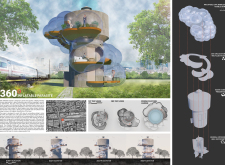5 key facts about this project
The main structure consists of a robust cylindrical concrete core that supports surrounding inflatable bubbles, allowing for flexibility and versatility. Each bubble serves as a separate living space, promoting an efficient use of available urban land. The core acts as a stable anchor, facilitating safe support for these inflatable units while maintaining a cohesive architectural form.
Innovative Adaptation to Urban Living
One of the distinctive features of the 360º Inflatable Parasite is its use of inflatable technology combined with a strong concrete core. This approach is notable in the field of architecture as it permits a lightweight and adaptable configuration, which contrasts with traditional static building designs. The design fosters an environment where individual units can adapt to various user needs while enabling interconnectivity among residents.
Additionally, the integration of sustainable materials, such as ethylene tetrafluoroethylene (ETFE) for the inflatable components and recycled wood for surrounding structural elements, underscores a commitment to environmental responsibility. This choice of materials not only ensures functionality but also enhances the aesthetic appeal of the design, allowing natural light to filter through, uniting interior spaces with the exterior landscape. The project is designed with communal spaces that encourage social interactions, aligning itself with modern urban living practices.
Functionality and Structure
Functionally, the 360º Inflatable Parasite provides innovative living quarters that blend seamlessly into the fabric of city life. The individual bubbles are designed not only for privacy but also to optimize views of the surrounding area, enhancing the living experience while maintaining a sense of community. The proposal includes features that facilitate sustainability, such as a preserved water tank system integrated into the overall architecture. This attention to resource management enhances the potential for self-sufficiency within the urban context.
The design’s circular layout allows for a complete 360-degree engagement with urban life, ensuring that each unit benefits from natural light and ventilation. The decision to use a dynamic, modular structure opens pathways for various adaptations and potential reconfigurations based on the evolving needs of the city, making it a practical solution for increasing urban density.
In summary, the 360º Inflatable Parasite articulates a thoughtful approach to modern urban housing through its innovative use of materials and structural design. For those interested in understanding the detailed aspects of this project, including architectural plans, sections, and design elements, exploring the presentation of the 360º Inflatable Parasite will provide a deeper insight into its architectural significance.























